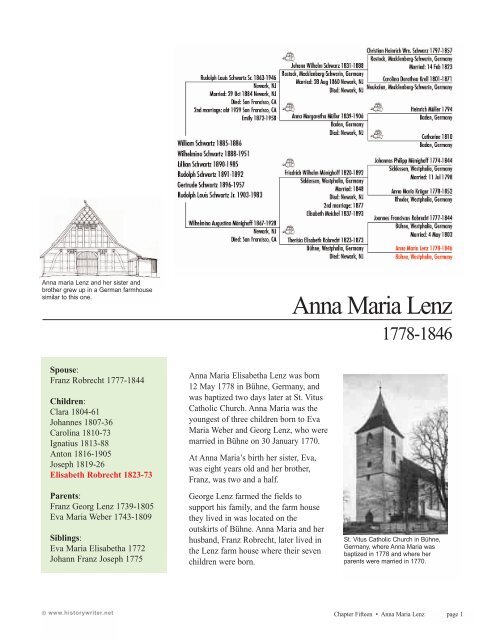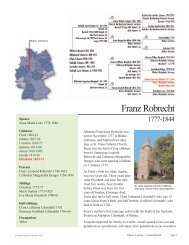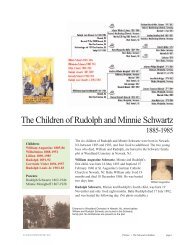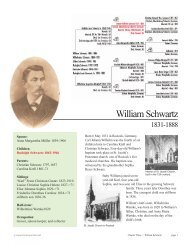Anna Maria Lenz - Schwartz Family History
Anna Maria Lenz - Schwartz Family History
Anna Maria Lenz - Schwartz Family History
You also want an ePaper? Increase the reach of your titles
YUMPU automatically turns print PDFs into web optimized ePapers that Google loves.
<strong>Anna</strong> maria <strong>Lenz</strong> and her sister and<br />
brother grew up in a German farmhouse<br />
similar to this one.<br />
<strong>Anna</strong> <strong>Maria</strong> <strong>Lenz</strong><br />
1778-1846<br />
Spouse:<br />
Franz Robrecht 1777-1844<br />
Children:<br />
Clara 1804-61<br />
Johannes 1807-36<br />
Carolina 1810-73<br />
Ignatius 1813-88<br />
Anton 1816-1905<br />
Joseph 1819-26<br />
Elisabeth Robrecht 1823-73<br />
Parents:<br />
Franz Georg <strong>Lenz</strong> 1739-1805<br />
Eva <strong>Maria</strong> Weber 1743-1809<br />
Siblings:<br />
Eva <strong>Maria</strong> Elisabetha 1772<br />
Johann Franz Joseph 1775<br />
<strong>Anna</strong> <strong>Maria</strong> Elisabetha <strong>Lenz</strong> was born<br />
12 May 1778 in Bühne, Germany, and<br />
was baptized two days later at St. Vitus<br />
Catholic Church. <strong>Anna</strong> <strong>Maria</strong> was the<br />
youngest of three children born to Eva<br />
<strong>Maria</strong> Weber and Georg <strong>Lenz</strong>, who were<br />
married in Bühne on 30 January 1770.<br />
At <strong>Anna</strong> <strong>Maria</strong>’s birth her sister, Eva,<br />
was eight years old and her brother,<br />
Franz, was two and a half.<br />
George <strong>Lenz</strong> farmed the fields to<br />
support his family, and the farm house<br />
they lived in was located on the<br />
outskirts of Bühne. <strong>Anna</strong> <strong>Maria</strong> and her<br />
husband, Franz Robrecht, later lived in<br />
the <strong>Lenz</strong> farm house where their seven<br />
children were born.<br />
St. Vitus Catholic Church in Bühne,<br />
Germany, where <strong>Anna</strong> <strong>Maria</strong> was<br />
baptized in 1778 and where her<br />
parents were married in 1770.<br />
© www.historywriter.net<br />
Chapter Fifteen • <strong>Anna</strong> <strong>Maria</strong> <strong>Lenz</strong> page 1
The <strong>Schwartz</strong> <strong>Family</strong> <strong>History</strong><br />
The George <strong>Lenz</strong> farmhouse was located on the outskirts of Bühne. The road leading off the bottom center of<br />
the above photograph is the one on which the farmhouse was located. A new house has replaced the old one,<br />
which was destroyed by the bombs of WW II. Farming fields can still be seen in this 1981 photo of Bühne.<br />
The earliest record of <strong>Anna</strong> <strong>Maria</strong> <strong>Lenz</strong>’s<br />
ancestors in Bühne is the 1669 marriage<br />
of her great-great grandparents, Henrici<br />
Krull and Elisabeth Heerdemert.<br />
In the early 1600s, German churches<br />
were mandated to keep written records<br />
of births, marriages, and deaths.<br />
However, recordkeeping in most areas of<br />
Germany began in the decades following<br />
the end of Thirty Years War (1618-48),<br />
during which entire villages were wiped<br />
from the map and bare survival took<br />
priority over record keeping.<br />
<strong>Anna</strong> <strong>Maria</strong> <strong>Lenz</strong>’s 1778 baptism recorded in the Bühne parish church record book.<br />
© www.historywriter.net<br />
Chapter Fifteen • <strong>Anna</strong> <strong>Maria</strong> <strong>Lenz</strong> page 2
The <strong>Schwartz</strong> <strong>Family</strong> <strong>History</strong><br />
LIFE ON THE LENZ FARM<br />
Like hundreds of villages dotting the north<br />
central German farmlands, Bühne was<br />
populated with barn-like farm houses,<br />
home to both humans and animals.<br />
A barn was the central feature inside the<br />
farm house with animal stalls on one side<br />
and family living quarters on the other.<br />
Large double barn doors accommodated<br />
wagons, oxen, and cattle. The loft held<br />
drying farm produce and smoked meats<br />
hung on large hooks. The ground floor<br />
housed cattle, horses, pigs, chickens,<br />
geese, rabbits, and whatever else the<br />
farmer used to support his family. Grain<br />
and dried fruit were secured in barrels.<br />
Smoke from an ever-smoldering fire hung<br />
in the rafters, curing meats, drying crops,<br />
repelling bugs, and killing bacteria. No<br />
chimney or hood caught the smoke that<br />
slowly drifted through the thatched roof<br />
and open windows into the cool damp<br />
German sky.<br />
A wood burning iron stove, used for both<br />
cooking and heating, stood in a combined<br />
kitchen, dining, and living space. Coal oil<br />
lamps provided light.<br />
Photo of the<br />
interior of an old<br />
farm house<br />
showing a fire<br />
grate placed<br />
over an open<br />
fire. Smoke from<br />
the flames cured<br />
meat and kept<br />
harvested crops<br />
from molding.<br />
Photo from a<br />
museum in<br />
Cloppenburg,<br />
Niedersachsen.<br />
Bedrooms were unheated. A mattress<br />
consisted of several feet of straw within a<br />
burlap envelope covered with a sheet.<br />
Children went to bed wearing longjohns,<br />
slept under feather down comforters, and<br />
snuggled up to blanket-wrapped hot bricks.<br />
Young children helped with keeping the<br />
farmyard tidy, caring for the animals, and<br />
harvesting crops. Older children watched<br />
over cows and sheep in the afternoons.<br />
With confirmation at age 14, the relatively<br />
untroubled time of childhood came to an<br />
end. Boys went to work as farm laborers<br />
or became apprentices to craftsmen. Girls<br />
went to work as domestic servants.<br />
The farm passed from father to child when<br />
one of his married children took over the<br />
farm and entered into a legal agreement<br />
with his/her father and mother, who<br />
continued living on the farm. This<br />
agreement spelled out specifics, such as<br />
living quarters, pensions, field access, and<br />
food allowances due the retired farmer and<br />
his wife.<br />
This change of ownership normally took<br />
place when the farmer was around age 55<br />
and his married child was about 27. The<br />
new owner and his/her family nursed the<br />
old farmer and his wife through old age.<br />
This German bauerhaus (farm house) housed both<br />
humans and animals. The family living area and<br />
the animal stalls were usually, but not always,<br />
separated. Black lung disease often cut short<br />
the lives of human inhabitants when the<br />
curing smoke fires invaded the<br />
unpartitioned family living quarters.<br />
In the late seventeenth<br />
century the following<br />
labor and goods were<br />
due the Bühne manor<br />
house for rent/tax on<br />
one small farm:<br />
From Petri to Michaelis<br />
(22 February to 29<br />
September, the feast<br />
days of St. Peter and St.<br />
Michael) the farmer was<br />
required to work one<br />
day a week for the lord<br />
of the manor, and from<br />
Michaelis to Petri, one<br />
day every two weeks.<br />
Payment also included<br />
four scheffel (bushels)<br />
each of rye and oats,<br />
three shillings, four<br />
chickens, and 60 eggs.<br />
© www.historywriter.net<br />
Chapter Fifteen • <strong>Anna</strong> <strong>Maria</strong> <strong>Lenz</strong> page 3
The <strong>Schwartz</strong> <strong>Family</strong> <strong>History</strong><br />
Even the family dog<br />
helped out on the<br />
farm. Dog-driven<br />
grinding mills for<br />
corn and wheat can<br />
still be seen in<br />
many old barns.<br />
In 1812 Bühne’s human<br />
inhabitants numbered<br />
about 800. The following<br />
is Bühne’s animal<br />
population in 1812:<br />
Horses (3+ yrs) 110<br />
Donkeys 14<br />
Bulls 10<br />
Oxen 8<br />
Cows 257<br />
Pigs 200<br />
Beehives 34<br />
A typical farm workday began at 5 am<br />
with barn chores. At 6 am the first of<br />
five meals was served, consisting of<br />
bread and milk. Gardens and fields were<br />
tended until 9 am, when a second<br />
breakfast was consumed, consisting of<br />
sausage, cheese, bread, and milk. At<br />
noon everyone returned to the house for<br />
the main meal, a one-pot stew with<br />
potatoes, vegetables, and meat.<br />
The next meal was at 3 pm, consisting<br />
of cake, cookies, and coffee. Then back<br />
to work until 6 pm. Supper was served<br />
about 6:30 and consisted of the same<br />
one-pot stew from the noon meal.<br />
Everyone stumbled into bed by 8 or 9<br />
pm so they could repeat the routine the<br />
next day. On Sundays the family walked<br />
to the village church wearing their<br />
sabbath best.<br />
German peasant farmers lived in the<br />
village and farming fields started where<br />
the village ended. Farmers and farm<br />
hands, day laborers, were the majority<br />
of the professions scribed in village<br />
record books. Fields were tended by<br />
families and farm hands, and even those<br />
who were not farmers by profession<br />
cultivated vegetable patches on land<br />
surrounding their houses and cottages.<br />
Farms and houses were not owned but<br />
leased from the nobel family.<br />
Leaseholds were hereditary as long as<br />
the taxes were paid.<br />
All food was grown and cooked on the<br />
farm. During summer months smoked<br />
meat or poultry were eaten. Butchering<br />
was done in the winter.<br />
1925 photo of a Bühne field being harvested in much the same way as the<br />
<strong>Lenz</strong> family did 200 years ago.<br />
© www.historywriter.net<br />
Chapter Fifteen • <strong>Anna</strong> <strong>Maria</strong> <strong>Lenz</strong> page 4
The <strong>Schwartz</strong> <strong>Family</strong> <strong>History</strong><br />
ALIFE IN BÜHNE<br />
Bühne village life centered around family<br />
and church. Celebrating weddings,<br />
confirmations, and births in addition to the<br />
many feast days of the saints was the core<br />
of village social life. The earliest marriage<br />
records were noted not by day and month<br />
but by the saint on whose feast the<br />
marriage occurred, such as Festum Jacobi<br />
(Latin for the Feast day of St. James,<br />
which was July 25)<br />
Common squabbles were settled by either<br />
the nobel of the manor or by village<br />
priest. No government authority existed<br />
for the administration of common justice,<br />
therefore most civil matters were handled<br />
by the church and the nobility.<br />
In Germany the sharpest social division<br />
occurred between the landed nobility (the<br />
families who owned the land) and the<br />
peasants (those who paid rent/tax with<br />
labor and goods to lease their farms and<br />
cottages from the nobility)<br />
Three social classes existed in the peasant<br />
population:<br />
• The first class (about 3%) consisted of<br />
farmers who possessed leaseholds on the<br />
big farms.<br />
• The common farmers (60-80%) made up<br />
the second class. These farmers worked<br />
hard and usually provided a modest<br />
standard of living for themselves and their<br />
families. Also in this category were<br />
craftsmen such as tailors, shoemakers,<br />
smiths, and cartwrights.<br />
• The third class consisted of day laborers<br />
(20-40%), who worked for other farmers<br />
for day wages and were very, very poor.<br />
The barn area of the farm house was the ideal location to celebrate a marriage,<br />
as depicted in the painting above of a peasant marriage feast.<br />
People normally married within their<br />
social class. <strong>Anna</strong> <strong>Maria</strong> <strong>Lenz</strong>, daughter<br />
of a common farmer, married a tailor, who<br />
was the son of a tailor. Women who bore<br />
a child out of wedlock sometimes married<br />
below their class, as was the case with<br />
<strong>Anna</strong> <strong>Maria</strong> <strong>Lenz</strong>’s daughter, Carolina<br />
Robrecht, who married a day laborer.<br />
Old Bühne village street scene.<br />
© www.historywriter.net<br />
Chapter Fifteen • <strong>Anna</strong> <strong>Maria</strong> <strong>Lenz</strong> page 5
The <strong>Schwartz</strong> <strong>Family</strong> <strong>History</strong><br />
Bühne’s population grew steadily from<br />
700 inhabitants in 1803 to 1,055 in 1852,<br />
a peak year of German emigration to<br />
America. The village population slowly<br />
declined through the next four heavy<br />
emigration decades to a low of 805 in<br />
1895. By 1989 Bühne’s population<br />
reached 1,369.<br />
MARRIAGE AND CHILDREN<br />
<strong>Anna</strong> <strong>Maria</strong> <strong>Lenz</strong> married Franz Robrecht<br />
in Bühne on 4 May 1803. <strong>Anna</strong> <strong>Maria</strong><br />
and Franz had seven children from 1804<br />
to 1823. Read about the lives of their<br />
children in the Franz Robrecht biography,<br />
chapter 15.<br />
<strong>Anna</strong> <strong>Maria</strong> and Franz lived with her<br />
parents in the <strong>Lenz</strong> farm house where the<br />
seven Robrecht children were born. <strong>Anna</strong><br />
<strong>Maria</strong>’s older sister, Eva, also married in<br />
1803, and she and her husband, Bernard<br />
Wagener, and their six children also lived<br />
in the farm house. Three of the Wagener<br />
children died in childhood and Bernard<br />
Wagener died in 1823.<br />
The 1770 marriage record record of <strong>Anna</strong> <strong>Maria</strong> <strong>Lenz</strong>’s parents, Franciscus<br />
Georgius <strong>Lenz</strong> and Eva <strong>Maria</strong> Weber.<br />
<strong>Anna</strong> <strong>Maria</strong> <strong>Lenz</strong>’s father died of cancer<br />
on 3 March 1805 at age 65, and her<br />
mother died on 23 April 1809 at age 66.<br />
Around 1829 the Robrechts moved from<br />
the farm house to a house in the village.<br />
<strong>Anna</strong> <strong>Maria</strong> <strong>Lenz</strong> Robrecht lived to see<br />
12 of her 38 grandchildren, of which only<br />
three lived out their adult lives in<br />
Germany. <strong>Anna</strong> <strong>Maria</strong> died in Bühne,<br />
Germany, on 14 November 1846 at age<br />
68. She was buried two days later in the<br />
Bühne church cemetery, joining her<br />
husband, Franz Robrecht, who died two<br />
years earlier at age 67.<br />
The 1803 marriage record record of <strong>Anna</strong> <strong>Maria</strong> <strong>Lenz</strong> and Franz Robrecht. The witnesses are<br />
Bernard Weber, the brides uncle, and Herman Liliendahl, the groom’s cousin.<br />
© www.historywriter.net<br />
Chapter Fifteen • <strong>Anna</strong> <strong>Maria</strong> <strong>Lenz</strong> page 6






